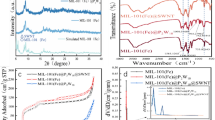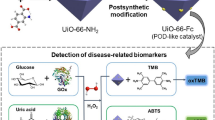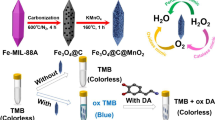Abstract
Over the past few decades, the enzyme-mimicking activity of metal–organic frameworks (MOFs) accompanied with structural characteristics has aroused much attention. However, pure MOFs have low affinity with DNA. Here, iron-based MOFs with acidized carbon nanotubes (CNTs) via a simple hydrothermal process have been synthesized, named as MIL-88(NH2)-Fe@CNTs. CNTs can enhance the affinity between MOF and DNA, achieving flexible regulation of their catalytic activity benefiting from the strong π − π stacking between CNTs and DNA. Meanwhile, in comparison with conventional iron-based MOFs, the addition of CNTs, which contributes to the acceleration of electron transfer, endowing as-prepared nanocomposites remarkably enhanced peroxidase-like activity to achieve an ultrasensitive detection of H2O2 with the LOD of 17.64 μg/L. Notably, the as-prepared nanocomposites with adsorbed DNA displayed excellent affinity towards both TMB (3, 3′, 5, 5′-tetramethylbenzidine) substrates and H2O2 as well as high catalytic velocity. On the basis of their switchable peroxidase-like activity regulated by different length or sequence of ssDNA, it is believed that our-prepared MOF-based nanomaterials would be promising for fabricating versatile and sensitive label-free colorimetric assays for diverse targets.








Similar content being viewed by others
References
Wei H, Wang E. Nanomaterials with enzyme-like characteristics (nanozymes): next-generation artificial enzymes. Chem Soc Rev. 2013;42(14):6060–93.
Xia XH, et al. Pd-Ir Core-Shell Nanocubes: a Type of Highly Efficient and Versatile Peroxidase Mimic. ACS Nano. 2015;9(10):9994–10004.
Gao LZ, et al. Intrinsic peroxidase-like activity of ferromagnetic nanoparticles. Nat Nanotechnol. 2007;2(9):577–83.
Kim CK, et al. Ceria Nanoparticles that can Protect against Ischemic Stroke. Angew Chem Int Ed. 2012;51(44):11039–43.
Manea F, et al. Nanozymes: gold-nanoparticle-based transphosphorylation catalysts. Angew Chem Int Ed. 2004;43(45):6165–9.
Song YJ, et al. Selective and quantitative cancer cell detection using target-directed functionalized graphene and its synergetic peroxidase-like activity. Chem Commun. 2011;47(15):4436–8.
Zhang EH, et al. Porous Ce3O4 hollow nanododecahedra for nonenzymatic glucose biosensor and biofuel cell. Biosens Bioelectron. 2016;81:46–53.
Huxford RC, Della Rocca J, Lin WB. Metal-organic frameworks as potential drug carriers. Curr Opin Chem Biol. 2010;14(2):262–8.
Li J, et al. Metal-organic framework-based materials: superior adsorbents for the capture of toxic and radioactive metal ions. Chem Soc Rev. 2018;47(7):2322–56.
Li WJ, et al. In Situ Growth of Metal-Organic Framework Thin Films with Gas Sensing and Molecule Storage Properties. Langmuir. 2013;29(27):8657–64.
Eddaoudi M, et al. Systematic design of pore size and functionality in isoreticular MOFs and their application in methane storage. Science. 2002;295(5554):469–72.
Chen BL, et al. A Luminescent Metal-Organic Framework with Lewis Basic Pyridyl Sites for the Sensing of Metal Ions. Angewe Chem Int Ed. 2009;48(3):500–3.
Nath I, Chakraborty J, Verpoort F. Metal organic frameworks mimicking natural enzymes: a structural and functional analogy. Chem Soc Rev. 2016;45(15):4127–70.
Gao W, et al. A competitive coordination-based CeO2 nanowire-DNA nanosensor: fast and selective detection of hydrogen peroxide in living cells and in vivo. Chem Commun. 2016;52(18):3643–6.
Qin FX, et al. Hemin@metal-organic framework with peroxidase-like activity and its application to glucose detection. Catal Sci Technol. 2013;3(10):2761–8.
Wang SQ, et al. Copper-based metal organic framework nanoparticles with peroxidase-like activity for sensitive colorimetric detection of Staphylococcus aureus. ACS Appl Mater Interfaces. 2017;9(29):24440–5.
Yang LZ, et al. An electrochemical sensor for H2O2 based on a new Co-metal-organic framework modified electrode. Sens Actuators B-Chem. 2015;215:489–96.
Jayasena SD. Aptamers: an emerging class of molecules that rival antibodies in diagnostics. Clin Chem. 1999;45(9):1628–50.
Chen M, et al. A novel aptamer- metal ions- nanoscale MOF based electrochemical biocodes for multiple antibiotics detection and signal amplification. Sens Actuators B-Chem. 2017;242:1201–9.
Fu Y, et al. DNA-Based platinum nanozymes for peroxidase mimetics. J Phys Chem C. 2014;118(31):18116–25.
Ning WY, et al. Imparting designer biorecognition functionality to metal-organic frameworks by a dna-mediated surface engineering strategy. Small. 2018;14(11):8.
Morris W, et al. Nucleic acid-metal organic framework (MOF) nanoparticle conjugates. J Am Chem Soc. 2014;136(20):7261–4.
Kempahanumakkagari S, et al. Biomolecule-embedded metal-organic frameworks as an innovative sensing platform. Biotechnol Adv. 2018;36(2):467–81.
Zhai YP, et al. Carbon materials for chemical capacitive energy storage. Adv Mater. 2011;23(42):4828–50.
Baughman RH, Zakhidov AA, de Heer WA. Carbon nanotubes–the route toward applications. Science. 2002;297(5582):787–92.
Xia Y, et al. A visible and colorimetric aptasensor based on DNA-capped single-walled carbon nanotubes for detection of exosomes. Biosens Bioelectron. 2017;92:8–15.
Peyvandi A, et al. Surface-modified graphite nanomaterials for improved reinforcement efficiency in cementitious paste. Carbon. 2013;63:175–86.
Shearer C, et al. Preparation and characterisation of vertically aligned single-walled carbon nanotube arrays on porous silicon. 2008; 7267.
Kim K, et al. Characterization of oxygen containing functional groups on carbon materials with oxygen K-edge X-ray absorption near edge structure spectroscopy. Carbon. 2011;49(5):1745–51.
Peng JB, et al. Catalytic effect of low concentration carboxylated multi-walled carbon nanotubes on the oxidation of disinfectants with Cl-substituted structure by a Fenton-like system. Chem Eng J. 2017;321:325–34.
Li X, et al. POMOF/SWNT Nanocomposites with Prominent Peroxidase-Mimicking Activity for L-Cysteine “On Off Switch” Colorimetric Biosensing. ACS Appl Mater Interfaces. 2019;11(18):16896–904.
Wang XT, et al. Integration of membrane filtration and photoelectrocatalysis on g-C3N4/CNTs/Al2O3 membrane with visible-light response for enhanced water treatment. J Membr Sci. 2017;541:153–61.
Horcajada P, et al. How linker’s modification controls swelling properties of highly flexible iron(III) dicarboxylates MIL-88. J Am Chem Soc. 2011;133(44):17839–47.
Xie DH, et al. Bifunctional NH2-MIL-88(Fe) metal-organic framework nanooctahedra for highly sensitive detection and efficient removal of arsenate in aqueous media. J Mater Chem A. 2017;5(45):23794–804.
Sun ZJ, Jiang JZ, Li YF. A sensitive and selective sensor for biothiols based on the turn-on fluorescence of the Fe-MIL-88 metal-organic frameworks-hydrogen peroxide system. Analyst. 2015;140(24):8201–8.
Bauer S, et al. High-throughput assisted rationalization of the formation of metal organic frameworks in the iron(III) aminoterephthalate solvothermal system. Inorg Chem. 2008;47(17):7568–76.
Pham MH, et al. Novel route to size-controlled Fe-MIL-88B-NH2 metal-organic framework nanocrystals. Langmuir. 2011;27(24):15261–7.
Zhang H, et al. Carbon nanotubes-incorporated MIL-88B-Fe as highly efficient Fenton-like catalyst for degradation of organic pollutants. Front Environ Sci Eng. 2019;13(2):11.
Tan B, et al. Fe3O4-AuNPs anchored 2D metal-organic framework nanosheets with DNA regulated switchable peroxidase-like activity. Nanoscale. 2017;9(47):18699–710.
Wang CH, Tang GG, Tan HL. Colorimetric determination of mercury(II) via the inhibition by ssDNA of the oxidase-like activity of a mixed valence state cerium-based metal-organic framework. Microchim Acta. 2018;185(10):8.
Liu M, et al. Stimuli-responsive peroxidase mimicking at a smart graphene interface. Chem Commun. 2012;48(56):7055–7.
Park KS, et al. Label-free colorimetric detection of nucleic acids based on target-induced shielding against the peroxidase-mimicking activity of magnetic nanoparticles. Small. 2011;7(11):1521–5.
Kim MI, Kim MS, Woo M-A, Ye Y, Kang KS, Lee J, Park HG. Highly efficient colorimetric detection of target cancer cells utilizing superior catalytic activity of graphene oxide–magnetic-platinum nanohybrids. Nanoscale. 2014;6(3):1529–36.
Acknowledgements
This work was supported by the National Natural Science Foundation of China (No. 21777012), the Program of Introducing Talents of Discipline to Universities (B13012), and the Program for Changjiang Scholars and Innovative Research Team in University (IRT_13R05).
Author information
Authors and Affiliations
Corresponding author
Electronic supplementary material
Below is the link to the electronic supplementary material.
About this article
Cite this article
Sun, S., Fan, Y., Du, J. et al. CNT-Modified MIL-88(NH2)-Fe for Enhancing DNA-Regulated Peroxidase-Like Activity. J. Anal. Test. 3, 238–245 (2019). https://doi.org/10.1007/s41664-019-00111-1
Received:
Accepted:
Published:
Issue Date:
DOI: https://doi.org/10.1007/s41664-019-00111-1




